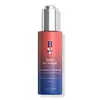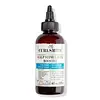What's inside
What's inside
 Key Ingredients
Key Ingredients

 Benefits
Benefits

 Concerns
Concerns

 Ingredients Side-by-side
Ingredients Side-by-side

Water
Skin ConditioningButylene Glycol
HumectantPPG-26-Buteth-26
Skin ConditioningPEG-40 Hydrogenated Castor Oil
EmulsifyingApigenin
AntioxidantOleanolic Acid
Skin ConditioningBiotinoyl Tripeptide-1
Quercus Serrata Extract
Skin ConditioningRosmarinus Officinalis Extract
AntimicrobialHydroxyethylcellulose
Emulsion StabilisingSophora Japonica Extract
EmollientNiacinamide
SmoothingAscorbic Acid
AntioxidantBisabolol
MaskingBiotin
AntiseborrhoeicHydrolyzed Rice Protein
Skin ConditioningTocopheryl Acetate
AntioxidantSodium PCA
HumectantPolysorbate 20
EmulsifyingCitrus Aurantium Dulcis Oil
MaskingVinegar
Dicalcium Phosphate
AbrasiveXanthan Gum
EmulsifyingPhenoxyethanol
PreservativeEthylhexylglycerin
Skin ConditioningLimonene
PerfumingWater, Butylene Glycol, PPG-26-Buteth-26, PEG-40 Hydrogenated Castor Oil, Apigenin, Oleanolic Acid, Biotinoyl Tripeptide-1, Quercus Serrata Extract, Rosmarinus Officinalis Extract, Hydroxyethylcellulose, Sophora Japonica Extract, Niacinamide, Ascorbic Acid, Bisabolol, Biotin, Hydrolyzed Rice Protein, Tocopheryl Acetate, Sodium PCA, Polysorbate 20, Citrus Aurantium Dulcis Oil, Vinegar, Dicalcium Phosphate, Xanthan Gum, Phenoxyethanol, Ethylhexylglycerin, Limonene
Water
Skin ConditioningPropanediol
SolventXanthan Gum
EmulsifyingPisum Sativum Sprout Extract
Skin ConditioningPaullinia Cupana Seed Extract
Skin ConditioningZingiber Officinale Root Extract
MaskingScutellaria Baicalensis Root Extract
AstringentHylocereus Undatus Fruit Extract
Skin ConditioningUrtica Dioica Leaf Extract
Skin ConditioningTriticum Vulgare Germ Extract
Skin ConditioningGlycine Soja Germ Extract
EmollientArginine
MaskingCaprylyl/Capryl Glucoside
CleansingCitric Acid
BufferingEthylhexylglycerin
Skin ConditioningGlyceryl Caprylate
EmollientPolyglyceryl-6 Oleate
EmulsifyingSodium Cocoyl Glutamate
CleansingGlycerin
HumectantGluconolactone
Skin ConditioningCalcium Gluconate
HumectantSodium Benzoate
MaskingPotassium Sorbate
PreservativeSodium Surfactin
CleansingPhenoxyethanol
PreservativeLactic Acid
BufferingHexyl Cinnamal
PerfumingAlpha-Isomethyl Ionone
PerfumingLinalool
PerfumingLimonene
PerfumingParfum
MaskingWater, Propanediol, Xanthan Gum, Pisum Sativum Sprout Extract, Paullinia Cupana Seed Extract, Zingiber Officinale Root Extract, Scutellaria Baicalensis Root Extract, Hylocereus Undatus Fruit Extract, Urtica Dioica Leaf Extract, Triticum Vulgare Germ Extract, Glycine Soja Germ Extract, Arginine, Caprylyl/Capryl Glucoside, Citric Acid, Ethylhexylglycerin, Glyceryl Caprylate, Polyglyceryl-6 Oleate, Sodium Cocoyl Glutamate, Glycerin, Gluconolactone, Calcium Gluconate, Sodium Benzoate, Potassium Sorbate, Sodium Surfactin, Phenoxyethanol, Lactic Acid, Hexyl Cinnamal, Alpha-Isomethyl Ionone, Linalool, Limonene, Parfum
Ingredients Explained
These ingredients are found in both products.
Ingredients higher up in an ingredient list are typically present in a larger amount.
Ethylhexylglycerin (we can't pronounce this either) is commonly used as a preservative and skin softener. It is derived from glyceryl.
You might see Ethylhexylglycerin often paired with other preservatives such as phenoxyethanol. Ethylhexylglycerin has been found to increase the effectiveness of these other preservatives.
Limonene is a fragrance that adds scent and taste to a formulation.
It's found in the peel oil of citrus fruits and other plants such as lavender and eucalyptus. The scent of limonene is generally described as "sweet citrus".
Limonene acts as an antioxidant, meaning it helps neutralize free radicals.
When exposed to air, oxidized limonene may sensitize the skin. Because of this, limonene is often avoided by people with sensitive skin.
The term 'fragrance' is not regulated in many countries. In many cases, it is up to the brand to define this term. For instance, many brands choose to label themselves as "fragrance-free" because they are not using synthetic fragrances. However, their products may still contain ingredients such as essential oils that are considered a fragrance.
Learn more about LimonenePhenoxyethanol is a preservative that has germicide, antimicrobial, and aromatic properties. Studies show that phenoxyethanol can prevent microbial growth. By itself, it has a scent that is similar to that of a rose.
It's often used in formulations along with Caprylyl Glycol to preserve the shelf life of products.
Water. It's the most common cosmetic ingredient of all. You'll usually see it at the top of ingredient lists, meaning that it makes up the largest part of the product.
So why is it so popular? Water most often acts as a solvent - this means that it helps dissolve other ingredients into the formulation.
You'll also recognize water as that liquid we all need to stay alive. If you see this, drink a glass of water. Stay hydrated!
Learn more about WaterXanthan gum is used as a stabilizer and thickener within cosmetic products. It helps give products a sticky, thick feeling - preventing them from being too runny.
On the technical side of things, xanthan gum is a polysaccharide - a combination consisting of multiple sugar molecules bonded together.
Xanthan gum is a pretty common and great ingredient. It is a natural, non-toxic, non-irritating ingredient that is also commonly used in food products.
Learn more about Xanthan Gum